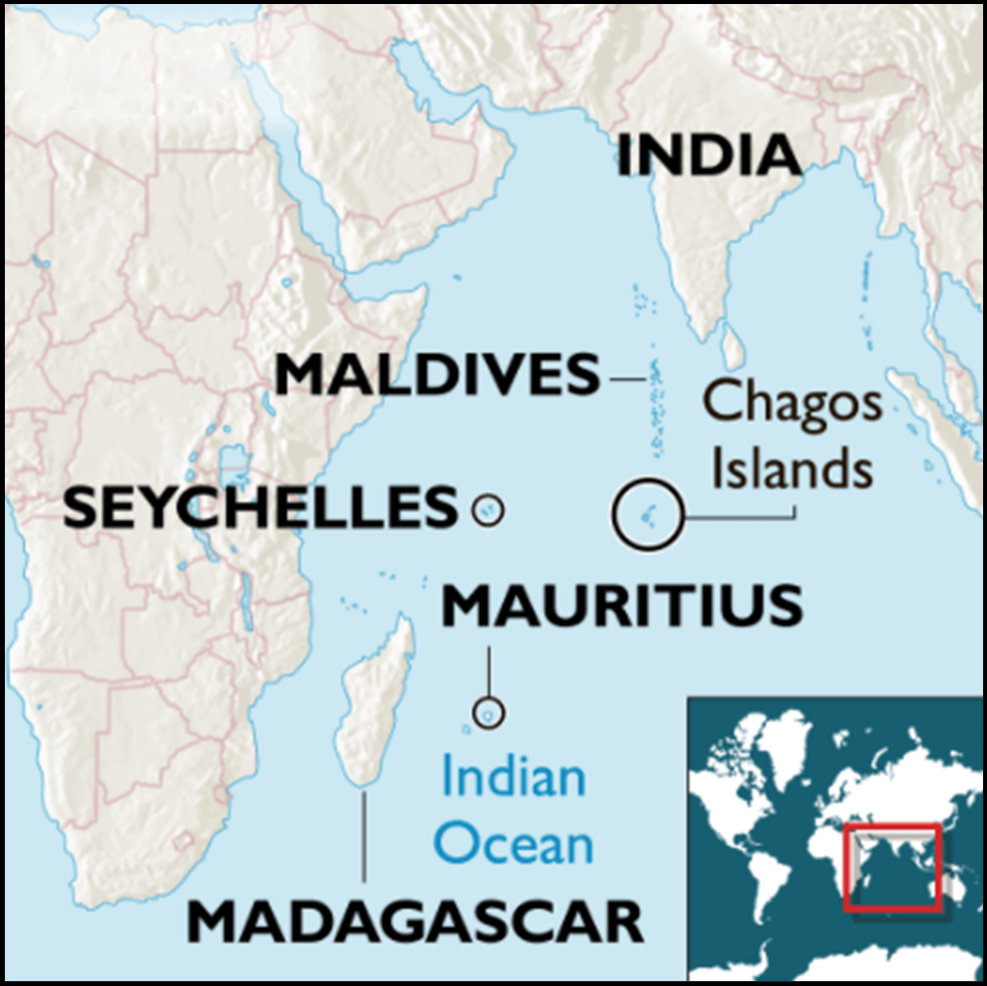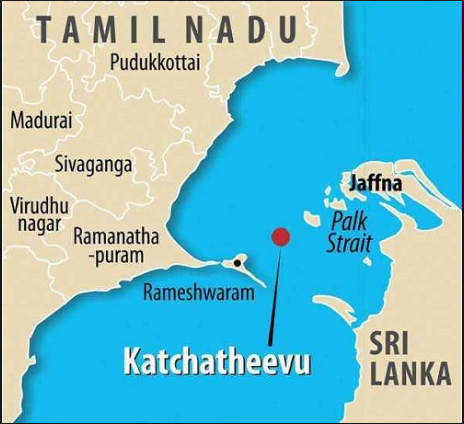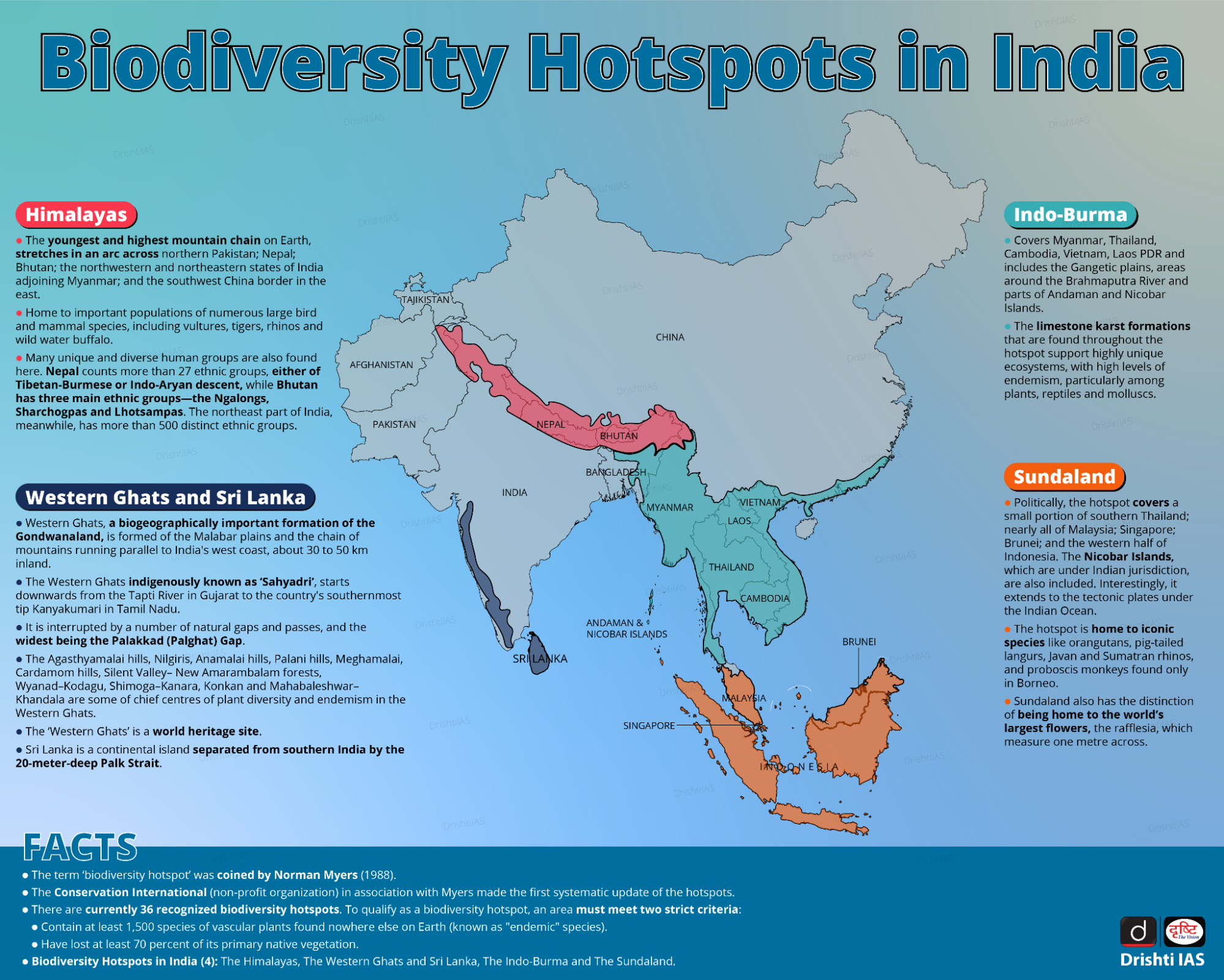India-Mauritius Relations
For Prelims: Comprehensive Economic Cooperation and Partnership Agreement, AIKEYME, African Continental Free Trade Area, Agaléga Island
For Mains: Significance of India-Mauritius Relations in the changing Indo-Pacific dynamics, India’s Neighbourhood First Policy and its regional implications.
Why in News?
During Mauritius Prime Minister’s visit to Varanasi, India was described as a trusted partner in Mauritius’ socio-economic development and as having steadfastly supported it at all times.
What are the Key Outcomes of Mauritius PM’s Visit to India?
- Development and Economic Support: India announced a Special Economic Package for Mauritius, covering the development of Port Louis, surveillance of the Chagos Marine Protected Area, and support for infrastructure, employment, and healthcare projects.
- The first Jan Aushadhi Kendra outside India has been established in Mauritius, and India will extend cooperation to set up an AYUSH Centre of Excellence.
- Community Development and Capacity Building: Signed an MOU for Phase 2 of High Impact Community Development Projects to strengthen development partnership.
- India will provide civil service capacity building for Mauritius using Mission Karmayogi as a reference platform.
- Energy: MoU signed on energy and power sector cooperation to help Mauritius meet energy needs, including a 17.5 MW floating solar power plant.
- Space cooperation: Signed an MoU on space cooperation for satellite telemetry, navigation, remote sensing, and capacity building.
How are India’s Relations with Mauritius?
- Diplomatic and Political Relations: India established diplomatic relations in 1948, before Mauritius’ independence (1968).
- The India-Mauritius Comprehensive Economic Cooperation and Partnership Agreement (CECPA), 2021 is the first trade agreement signed by India with an African country. Ties elevated to an Enhanced Strategic Partnership in 2025.
- Trade and Investment: India as a trading partner accounts for 11% of Mauritius’ imports in 2024, ranking third among its top trading partners.
- Key Indian exports are petroleum, pharmaceuticals, cereals, cotton, shrimps, and bovine meat.
- Key Mauritian exports are vanilla, medical devices, aluminium alloys, refined copper, and cotton shirts.
- Mauritius has contributed a cumulative 180B USD in foreign direct investment (FDI) to India from 2000 to 2025, accounting for 25% of total inflows, facilitated by the Double Taxation Avoidance Convention.
- In FY 2023–24, Mauritius was India's second-largest source of FDI after Singapore.
- Development and Cultural Ties: India supports healthcare, education, and cultural institutions like the Mahatma Gandhi Institute and the Indian Cultural Centre (largest abroad), with over 2,500 Mauritian students benefiting annually.
- People-to-People Links: Around 26,000 Indian nationals and 13,000 Overseas Citizenship of India (OCI) cardholders live in Mauritius.
- OCI eligibility has been extended to Mauritians with Indian ancestry up to seven generations.
- Tourism and Education: Tourism is strong between India and Mauritius, with visa-free entry for Indians and free visas for Mauritians.
- Strategic and Regional Cooperation: Mauritius is key to India’s Neighbourhood First Policy and Vision MAHASAGAR.
- India, through exercises like AIKEYME, trains Mauritian personnel, refits coast guard vessels, and strengthens maritime capabilities.
What is the Significance of the Bilateral Relationship Between India and Mauritius?
Significance of Mauritius for India
- Strategic Location: Mauritius’ position in the western Indian Ocean helps India secure sea lanes and maintain regional maritime security under SAGAR/MAHASAGAR.
- It acts as a counterbalance to China’s growing influence and strengthens India’s regional role.
- Economic Relations: Mauritius is a gateway for India’s trade and investment in Africa, as it is a part of African Continental Free Trade Area (AfCFTA).
Significance of India for Mauritius
- Development Partner: India has provided over USD 1 billion in the past decade and helps protect Mauritius’ Exclusive Economic Zone and trains its personnel.
- Disaster Relief: It acts as first responder during crises such as Wakashio oil spill (2020) Cyclone Chido (2024), and Covid-19.
What are the Challenges in India-Mauritius Relations?
- Dependency on Indian Assistance: Mauritius relies heavily on India for development aid, concessional credit, and grants. Over-reliance may push Mauritius to diversify its partnerships to avoid dependence on a single country for economic and security needs.
- Domestic policies and balancing relations with China, France, and the US complicate India’s engagement.
- Geopolitical Competition: Rising Chinese investments in Mauritius, including Jinfei Smart City and port projects, challenge India’s strategic influence.
- Limited Private Sector Engagement: Indian public sector enterprises dominate economic activity in Mauritius, while private sector participation remains low, limiting business innovation and trade diversification.
- Maritime Security: Piracy, drug trafficking, and illegal fishing threaten stability in the Western Indian Ocean.
- Trade Barriers: High logistics costs and limited direct shipping routes restrict bilateral trade.
What Should be the Way Forward to Strengthen Ties Between India and Mauritius?
- Trade, and Economic Partnership: Expand CECPA to include services, fintech, and digital trade.
- Introduce Rupee–Mauritian Rupee payment system and promote Mauritius as India’s financial gateway to Africa and encourage private sector investments, particularly in technology, AI, and financial services.
- Development and Sustainability: Oil spills, and coastal degradation threaten Mauritius’ economy and tourism to contour this prioritize green energy, water security, blue economy projects, climate adaptation, disaster management, and marine conservation.
- Strategic Cooperation: India should enhance Agaléga Island’s infrastructure and surveillance capabilities with Mauritius to boost maritime security, and regional strategic presence under MAHASAGAR.
- Financial and Regulatory Strengthening: Enhance anti-money laundering cooperation and reinforce Mauritius’ role as a global financial hub.
- Cultural and Diaspora Engagement: Promote Indian culture, heritage, Hindi language, scholarships, Indian Technical and Economic Cooperation programs, and establish a Pravasi Bharatiya Kendra to engage the diaspora.
Conclusion
India-Mauritius ties are a strategic, economic, and cultural partnership, with India supporting development and security, and Mauritius playing a key role in MAHASAGAR. Strengthening trade, sustainability, and diaspora engagement will ensure a resilient, mutually beneficial relationship.
|
Drishti Mains Question: Q. Discuss the strategic and economic significance of Mauritius for India in the context of the MAHASAGAR initiative. |
UPSC Civil Services Examination Previous Year Questions (PYQs)
Prelims:
Q. A great deal of Foreign Direct Investment (FDI) to India comes from Mauritius than from many major and mature economies like UK and France. Why? (2010)
(a) India has preference for certain countries as regards receiving FDI
(b) India has double taxation avoidance agreement with Mauritius
(c) Most citizens of Mauritius have ethnic identity with India and so they feel secure to invest in India
(d) Impending dangers of global climatic change prompt Mauritius to make huge investments in India.
Ans: (b)
Mains:
Q. Project ‘Mausam’ is considered a unique foreign policy initiative of Indian government to improve relationships with its neighbours. Does the project have a strategic dimension? Discuss. (2015)
India–Sri Lanka Fishing Dispute and Way Forward
Why in News?
The India–Sri Lanka fishing dispute highlights the need for a “humane approach” that balances fishing livelihoods with ecological conservation in the Palk Strait and around Katchatheevu island.
What is the India–Sri Lanka Fishing Dispute?
- Location: The dispute centers around the Palk Strait, the narrow body of water separating Tamil Nadu (India) and the Northern Province of Sri Lanka. Palk Strait connects the Palk Bay to the Bay of Bengal.
- Katchatheevu is a tiny, uninhabited islet in the Palk Strait. The dispute concerns this 285-acre island, which was ceded to Sri Lanka under the 1974 Maritime Boundary Agreement.
- While sovereignty is legally settled in Sri Lanka’s favour, Indian fishermen are allowed to visit the islet for drying nets and for religious purposes.
- Fishing rights remain a separate matter governed by historic practice, international law (United Nations Convention on the Law of the Sea (UNCLOS), 1982), and bilateral agreements.
- Katchatheevu is a tiny, uninhabited islet in the Palk Strait. The dispute concerns this 285-acre island, which was ceded to Sri Lanka under the 1974 Maritime Boundary Agreement.
- Communities involved: Traditional Tamil Nadu fishers and Sri Lanka’s Northern Province fishers have shared these waters for centuries.
- Key conflict: Indian mechanised trawlers enter Sri Lankan waters, engaging in bottom trawling, which is banned in Sri Lanka since 2017. This damages coral reefs, shrimp habitats, and depletes fish stocks.
- Small-scale artisanal fishers struggle to survive as mechanised trawlers pursue commercial profit, often damaging shared marine resources.
- The conflict is thus both cross-border (India–Sri Lanka) and intra-community (artisanal vs trawler operators in Tamil Nadu).
- High Seas Issues: Due to depleted fish stocks, Indian fishermen are increasingly venturing into the High Seas, leading to arrests in Maldivian waters and by the British Navy near Diego Garcia for allegedly crossing maritime boundaries.
What Measures Can Address the India–Sri Lanka Fishing Issue and Ensure Sustainable Fisheries?
- Distinguish livelihoods: Prioritise artisanal fishers who depend on traditional, sustainable methods. Phase out mechanised bottom trawling, which harms ecosystems and deprives both Indian and Sri Lankan small-scale fishers.
- Strengthen cooperation frameworks: Establish an India–Sri Lanka Fisheries Management Council with fisher groups, scientists, and officials.
- Use UNCLOS Article 123 to guide cooperation in the semi-enclosed Palk Strait and Gulf of Mannar.
- Consider joint quotas (similar to the Baltic Sea Fisheries Convention’s quota-sharing model), seasonal fishing rights, or regulated fishing days specifically for artisanal fishers.
- Invest in alternatives: Promote deep-sea fishing in India’s 200-nautical-mile Exclusive Economic Zone (EEZ) to reduce pressure on near-shore resources.
- Provide training, modern vessels, and financial support for fishers to transition away from destructive practices.
- Depoliticise Katchatheevu: Accept that sovereignty over Katchatheevu is legally settled under the 1974 Treaty. Debunk myths that it was “gifted” as historical records show Sri Lanka had stronger claims.
- Emphasise that fishing rights are separate from sovereignty and can still be negotiated cooperatively. Use Katchatheevu for joint marine research stations and as a hub for ecological cooperation.
- Foster community empathy: Highlight the wartime hardships of Sri Lankan Tamil fishers to build goodwill in Tamil Nadu. Encourage people-to-people ties, recalling Tamil Nadu’s humanitarian support during Sri Lanka’s civil war.
Conclusion
The Katchatheevu and Palk Strait issues should be seen as opportunities for cooperation, not conflict. A fair fisheries regime that protects artisanal livelihoods and ecology is key. Smaller disputes must not overshadow the larger vision of peace and mutual respect in South Asia.
|
Drishti Mains Question: Q. The India–Sri Lanka fishing dispute reflects the clash between livelihood needs and ecological sustainability. Discuss |
UPSC Civil Services Examination, Previous Year Questions (PYQs)
Mains
Q. ‘India is an age-old friend of Sri Lanka.’ Discuss India's role in the recent crisis in Sri Lanka in the light of the preceding statement. (2022)
Q. In respect of India-Sri Lanka relations, discuss how domestic factors influence foreign policy. (2013)
Isobutanol Blending with Diesel
India is now exploring isobutanol blending with diesel after unsuccessful ethanol-diesel trials, highlighting the government’s push for biofuels to support farmers, reduce oil imports, and ensure sustainable energy use.
- Isobutanol: It is a four-carbon alcohol (C₄H₁₀O), flammable, colorless, and traditionally used as a solvent in paints, coatings, and chemical industries. It is produced both from petrochemical processes and fermentation of biomass.
- Properties (vs. Ethanol): Higher energy density than ethanol (closer to diesel).
- It has lower hygroscopicity (absorbs less water than ethanol), reducing risks of corrosion in engines and pipelines.
- Isobutanol Blending Trials: Automotive Research Association of India (ARAI) is testing 10% isobutanol–diesel blends.
- Isobutanol is also being explored as an independent fuel and in Compressed Natural Gas (CNG)-isobutanol flex-fuel options for tractors and agri-machinery.
- Benefits for India: Isobutanol enhances energy security while promoting a cleaner alternative to fossil fuels. Supports India’s National Biofuel Policy (2018) goals of energy transition and farmer income support.
Samudra Pradakshina
Defence Minister flagged off ‘Samudra Pradakshina’, the world’s first-ever Tri-service all-women sailing circumnavigation expedition, symbolising Nari Shakti, jointness of Armed Forces, Aatmanirbhar Bharat, and India’s maritime vision.
- It builds on India’s earlier circumnavigation milestones by Captain Dilip Donde (2009–10), Commander Abhilash Tomy (2012–13), and the Indian Navy’s Navika Sagar Parikrama (2017–18) and Navika Sagar Parikrama-II (2024–25).
- Expedition: The crew, led by Lt Col Anuja Varudkar, consists of 10 women officers who will sail on the indigenously built Indian Army Sailing Vessel (IASV) Triveni for 9 months, covering 26,000 nautical miles.
- Their route crosses the Equator twice and rounds the three great Capes (Leeuwin, Horn, and Good Hope), including the challenging Southern Ocean and Drake Passage.
- They will make international port calls at Fremantle (Australia), Lyttelton (New Zealand), Port Stanley (Canada), and Cape Town (South Africa), strengthening India’s maritime diplomacy.
- It also has a scientific component, with collaboration from the National Institute of Oceanography to study microplastics, marine biodiversity, and ocean health.
- Global Standards: The expedition adheres to the World Sailing Speed Record Council, requiring the crossing of all longitudes, Equator crossings and completion of over 21,600 nautical miles under sail alone, without use of canals or powered transit, making it a true test of endurance.
|
Read more: Navika Sagar Parikrama II |
Black Aspergillus in Western Ghats
Scientists have discovered two new species of black aspergillus (Aspergillus dhakephalkarii and Aspergillus patriciawiltshireae), from the Western Ghats, marking India’s first study in this group using advanced polyphasic taxonomy.
- The Western Ghats is a UNESCO World Heritage site and one of the eight "hottest hotspots" of biodiversity.
Black Aspergillus
- It comprises a diverse group of filamentous fungi that are ubiquitously distributed across various ecological niches and are of considerable medical, industrial, and ecological significance.
- Also known as ‘workhorses of industrial application’ especially in citric acid production, food mycology, fermentation technology, and agriculture.
World’s 8 ‘Hottest Biodiversity Hotspots
- There are 8 recognized “hottest hotspots” due to their exceptional species richness and endemism.
- Madagascar – 90% of wildlife found nowhere else on Earth; home to lemurs, chameleons, baobab trees.
- Philippines – Over 52,000 species; rich rainforests, coral reefs, and mangroves; includes Philippine eagle, tarsier.
- Sundaland (SE Asia) – Oldest tropical rainforests; orangutan, Sumatran tiger, pygmy elephant.
- Brazil’s Atlantic Forests – Only ~12% remains; golden lion tamarin, sloth, diverse plants.
- Caribbean Islands – 7,000+ islands; tropical forests, reefs, mangroves; unique birds, reptiles, amphibians.
- Indo-Burma Region – NE India to Vietnam; saola, highly endangered.
- Western Ghats & Sri Lanka – Endemics like lion-tailed macaque, Nilgiri tahr, Sri Lankan leopard.
- Eastern Arc & Coastal Forests (Tanzania & Kenya) – Ancient forests, endemic owls, colobus monkeys, unique plants.



